
Rasboras are so many types of rasboras to choose from. These lively little swimmers add a splash of color, brighten up the aquarium, and generally add a touch of life to the water. They are also docile and peaceful, making them great tankmates for various other types of fish.
Types of rasboras include blackline rasbora, chili rasbora, green neon rasbora, lambchop rasbora, harlequin rasbora, celestial pearl danio, and strawberry rasbora. They have a variety of colors, some with bright yellow and red stripes, others with deep blue and black hues.
These fish come in different sizes and shapes, from the tiny celestial pearl danio to the larger harlequin rasbora. In this article, I’ll go in-depth about 15 types of rasboras, along with pictures of each, to help you decide which one is best for your tank.
1. Blackline Rasbora ‘Rasbora borapetensis’
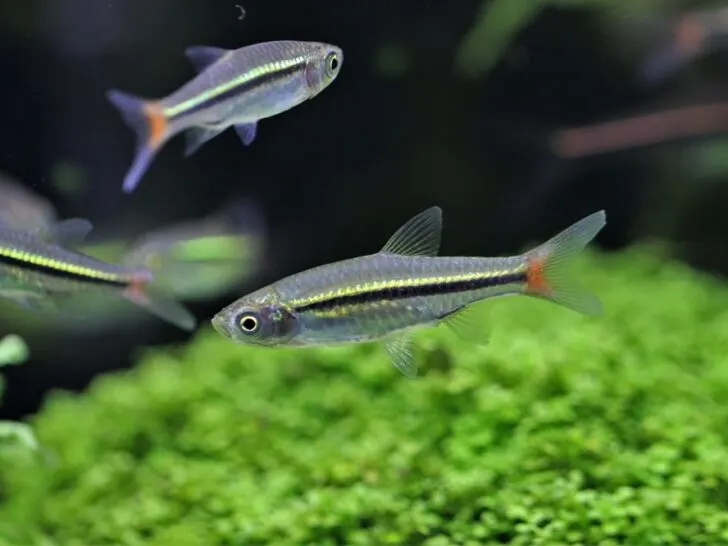
The Blackline Rasbora is a stunning fish growing up to 2.5 inches (6.35 cm). Its name comes from the single black stripe that runs along its body from the gill cover to the tail. It also has a beautiful silver body with a yellow line just on top of the black line and a red tail fin, giving it a unique look.
It has a peaceful, laid-back personality and is compatible with species of similar temperament. The Blackline Rasbora is native to Thailand and does well in somewhat acidic water.
It also does best in a tank with plenty of plants and some hiding places.
This rasbora is a peaceful fish that enjoys being in small schools of about six. It is a carnivore and can eat frozen or live food. The ideal temperature for this fish is between 72-79 degrees Fahrenheit (22-26 degrees Celsius).
They prefer slow-moving water, so a power filter is not ideal. If you’re a beginner aquarium owner, this fish is a particularly good choice as it’s very easy to care for and maintain.
They live in bodies of water that are deeper than others, so they can be found in the middle to bottom of aquariums. The minimum size of your fish tanks should be at least 15 gallons (57 liters) for these fish to thrive.
2. Galaxy Rasbora ‘Celestial Pearl Danio’
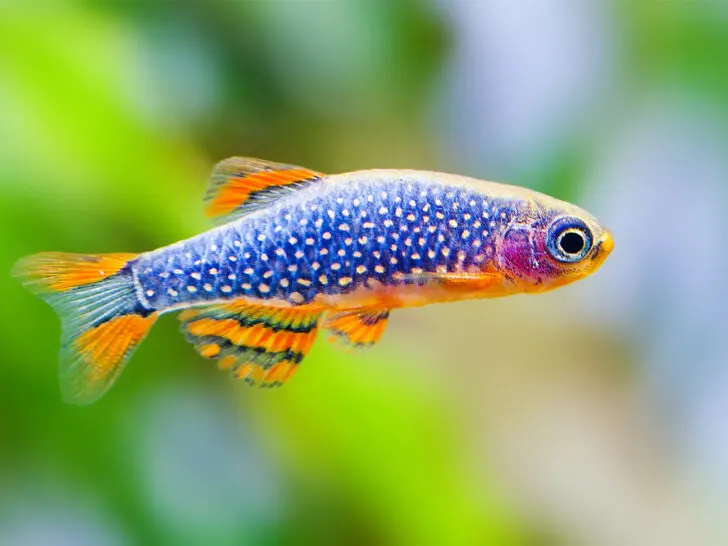
The Celestial Pearl Danio is a freshwater fish native to Myanmar. It’s also called the Galaxy Rasbora, which stems from the fact that its speckled body resembles the stars in the night sky.
They have an attractive, iridescent blue body with pearl-like spots, and their fins and tails have an orange to red coloration, making them one of the most colorful fish in the aquarium trade.
They are a very small species and only reach a maximum size of 1 inch (2.54 cm). These fish are also quite peaceful and can be kept in a community tank with other non-aggressive fish.
You can keep them in a small shoal of around five to seven individuals, as they will not do well if kept in isolation. They prefer to live in a tank with plenty of open swimming space, live plants, and floating vegetation.
Your tank should have a steady water temperature between 72 and 79 degrees Fahrenheit (22 and 26 degrees Celsius).
Galaxy Rasboras do well in warm, shallow waters in the wild, and if confined in an aquarium, still or slow-flowing water with a neutral pH is preferable.
They do not require a large tank and a minimum of 10 gallons (38 liters) is enough. These fish are sensitive and intolerant to ammonia and nitrate levels, so it is vital to regulate your water quality.
3. Chili Rasbora ‘Boraras brigittae’
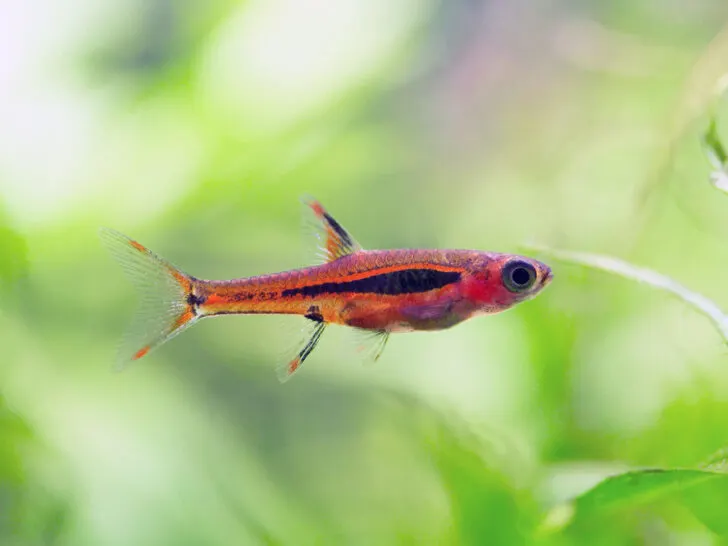
The Chili Rasbora ‘Boraras brigittae,’ also called the mosquito rasbora, is an incredibly small and colorful fish. You can find them in Southwest Borneo in Indonesia. This species rarely surpasses 1 inch (2.54 cm) in length, and its small size makes it perfect for nano tanks.
The Chili Rasbora is so named for its bright red coloration. It also has a black line from the gills to its tail fin, which is usually a pale pink or yellow, making it stand out in a tank.
Chili Rasboras are best kept in schools of at least six but avoid putting them with carnivorous fish as they may become prey. It is a carnivorous species that feeds primarily on small insects and invertebrates.
They are not great for a beginner as they are choosy about their water conditions. They prefer slightly acidic water and need a lot of oxygen for their gills to function properly. The water in your tank should not have any chemicals added and should have a pH of 4.0 to 7.0.
4. Clown Rasbora ‘Rasbora kalochroma’
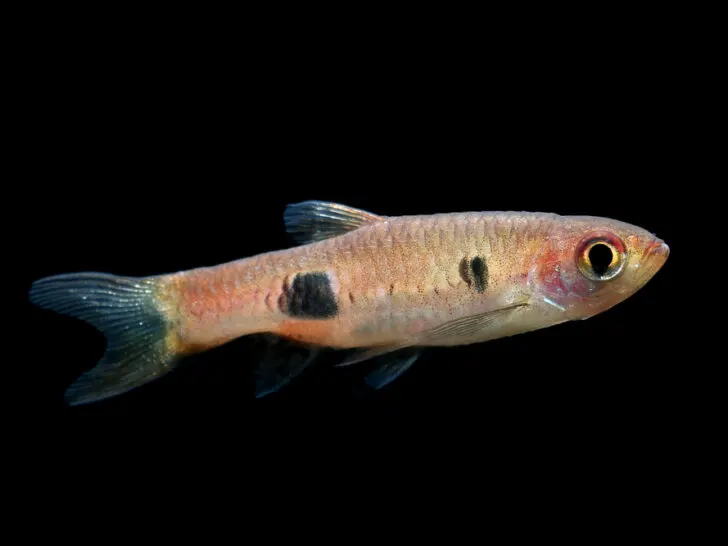
The Clown Rasbora, is one of the most colorful freshwater fish species in the aquarium industry. It is native to Southeast Asia and can be found in Thailand, Malaysia, and Sumatra.
They have rounded, elongated bodies that can grow up to 4 inches (10 cm) in length and feature a signature red and black-blue color pattern on their body. It is one of the larger species of rasboras and will likely become the center of attention in any aquarium tank.
Clown rasboras should be kept in a school of at least eight individuals. The tank should have plenty of vegetation, rocks, and driftwood to hide in as they are used to the blackwater streams in their natural habitats. This water contains tannin, is murky in color, and acidic in pH.
Therefore, try to replicate this environment as closely as possible in your aquarium. A pH of 4 and a temperature of 76-84 Fahrenheit (24-29 degrees Celsius) is the preferred range for these fish. Also, the aquarium should be dimly lit to make the Clown Rasbora more comfortable.
5. Fire Rasbora’ Rasboroides vaterifloris’
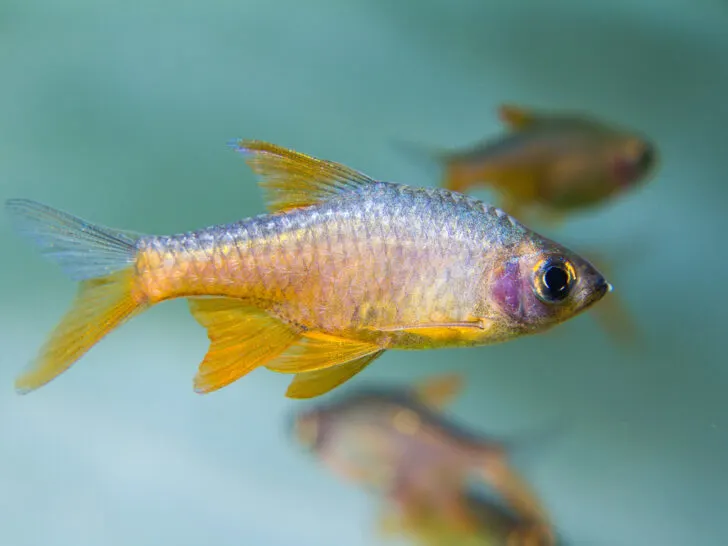
These vibrant fish look sun-kissed with their bright orange, red, or yellow bodies. The Fire Rasbora (Rasboroides vaterifloris) is a captivating and unique Rasbora species found in shallow stream beds of Southwest Sri Lanka.
Because of their extraordinary coloration, Fire Rasboras make a great centerpiece for any aquarium. These fish measure up to 1.6 inches (4 cm) when fully grown and live for around three to five years.
They are active fish, so they need plenty of space to swim. Fire Rasboras prefer tanks with plenty of foliage and a sandy or gravel substrate for them to thrive. They are quite peaceful, so they can be kept in a community tank with six other small, non-aggressive fish.
A 20-gallon (76-liter) tank is recommended for optimal health. When it comes to breeding, Fire Rasboras are egg scatterers and can be quite hard to breed in captivity. Maintain your aquarium temperature at 80 degrees Fahrenheit (27 degrees Celsius) or higher to encourage spawning.
6. Green Neon Rasbora ‘Microdevario kubotai’
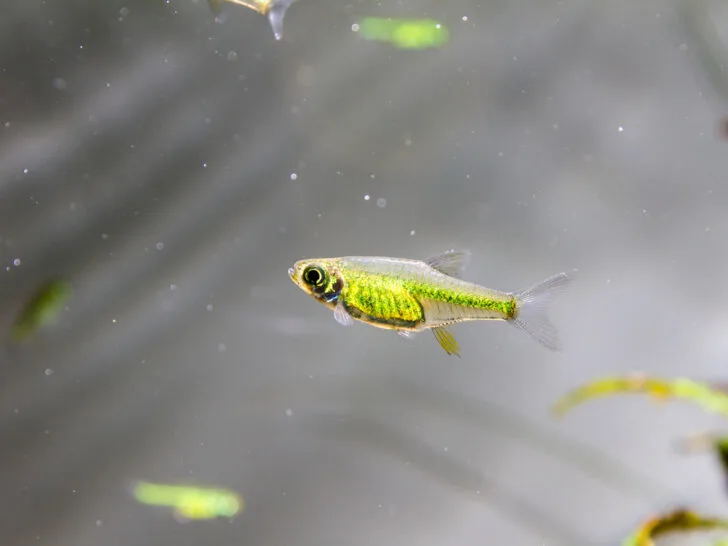
The Green Neon Rasbora, or Microdevario kubotai, is a schooling fish with an elongated body. They are grayish olive with a bright green, yellow stripe running along their backs and mid-section.
They grow up to 0.8 inches (2 cm) in length, so they do not require a large tank and can be kept in tanks as small as 10 gallons (38 liters). These little fish may be small, but they can make a big impact in the tank with their vibrant coloring and peaceful nature.
The Microdevario kubotai is a schooling fish, so you should keep them in a group of at least eight. They will swim around the tank, often in pairs, and can live peacefully with other small tankmates.
These fish do best in an aquarium with plenty of plants or driftwood. They enjoy a variety of foods, including live and frozen foods, as well as flake food. The Green Neon Rasbora is an omnivore and will happily feed on various foods, including frozen, live, and flakes.
They are low-maintenance fish that have a lifespan of 3-5 years. Water temperatures should be between 75-82°F (24-28°C), and a pH of 5.8 – 7.0 is ideal for these fish.
7. Harlequin Rasbora ‘Trigonostigma heteromorpha’
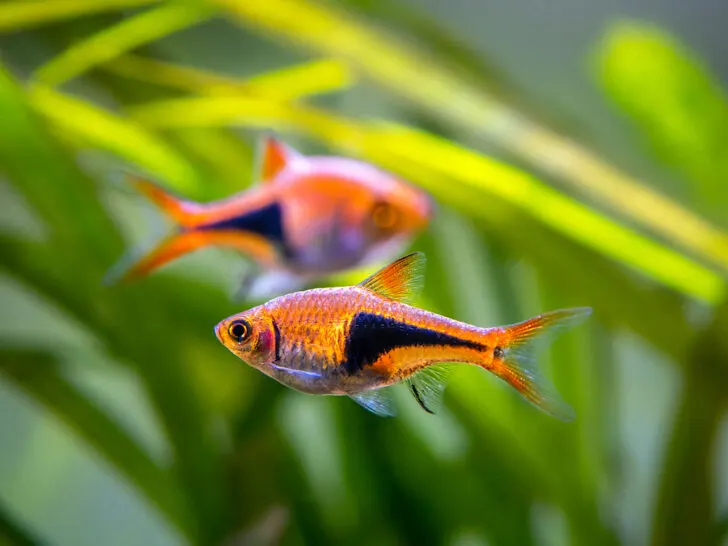
Native to the river systems of Southeast Asia, Harlequin Rasbora (Trigonostigma heteromorpha) is a colorful and popular species of fish. It is a striking fish with its diamond shape and colorful red and black triangular markings.
Harlequin Rasboras can grow up to two inches in length, and they prefer warm water temperatures around 78°F (26°C) with a pH of 5.5 – 8.0. They are schooling fish so keep them in groups of at least eight.
This species is carnivorous, so they should be fed high-quality fish foods, such as freeze-dried worms and brine shrimp. The Harlequin Rasbora is a peaceful fish, but it does not take well to bullying by larger or more aggressive tank mates.
Keep them with other peaceful species, and they will thrive in your aquarium. This species is not particularly hard to care for, but it does require good water quality and regular maintenance to stay healthy.
8. Lambchop Rasbora ‘Trigonostigma espei’
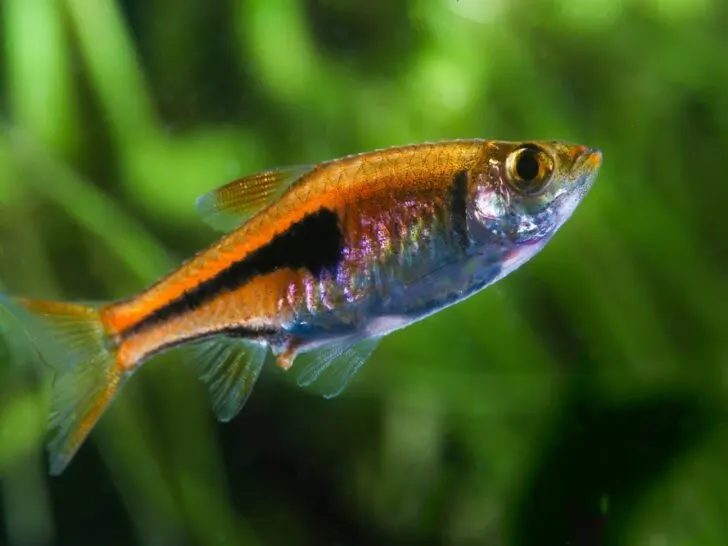
The Lambchop mirrors its name in appearance as it has a wedge shape mark which is black from the dorsal fin to the tailfin, much like a lamb chop. It’s mostly orange with a stripe of yellow running down its side.
This is an active species that loves to swim and explore the tank. It prefers plenty of open space with places to hide. Lambchop Rasboras are peaceful fish that love the company of their own kind, so it’s best to keep them in a school of at least six.
They are very playful and will dart around the tank, making it quite a sight. Lambchop Rasboras like to eat various foods, including flake food, bloodworms, and other small live or frozen food. They can grow up to 1.6 inches (4 cm) in length.
Your aquarium should hold at least 10 gallons of water and have sandy substrate and plenty of plants. This species is also known to spawn in the right conditions, so it would be ideal to include plenty of vegetation and hiding spots throughout the tank to promote it.
They thrive in water conditions within a pH range of 6.5-7.2, a temperature range of 73-82 degrees Fahrenheit (23-28 degrees Celsius), and a hardness level between 2 dGH.
These fish are quite hardy, and since they do well in a wide range of conditions, they’re a good choice for beginners.
9. Least Rasbora ‘Boraras urophthalmoides’
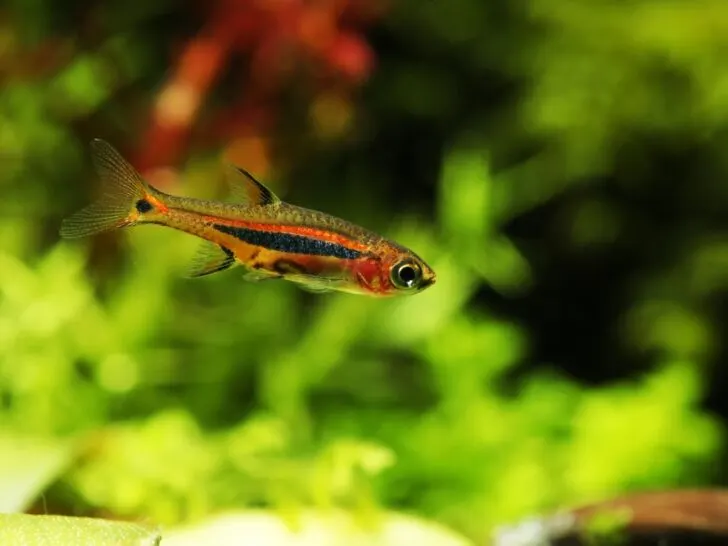
The Least Rasbora (Boraras urophthalmoides) is a small rasbora native to Southeast Asia. It is named for its unique black marking that looks like an exclamation point on its body.
It only grows to a maximum of 1 inch (2.54 cm) and is one of the smallest fish in the Rasbora family. It has a golden yellow coloring and a lateral greenish-brown stripe on both sides. Also, it has black speckles that look like freckles in the caudal peduncle and dorsal fin.
The Least Rasbora prefers soft, acidic water and should be kept in schools of at least 8-10. They are very peaceful and can be kept in tanks with various tank mates, but they should not be paired with fish with large mouths or aggressive tendencies.
Feeding the Least Rasbora can be a bit more challenging than other species, as they tend to look for food on the substrate or in the water column. They will accept small live and frozen foods such as baby brine shrimp, daphnia, and other small invertebrates.
This species is not particularly hardy, but with the right water parameters, diet, and tank mates, you can easily keep them as part of your aquarium.
10. Phoenix Rasbora ‘Boraras merah’
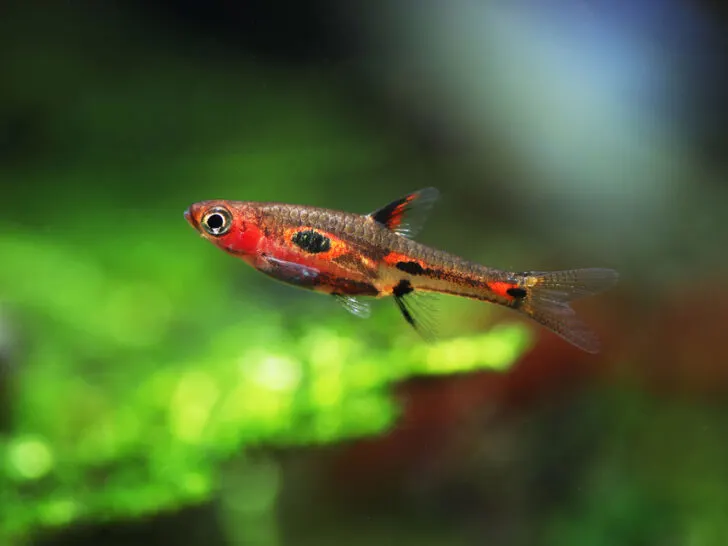
The Phoenix Rasbora (Boraras merah) is a species that originates from Sumatra and Java. It has a vibrant orange-red body with a black stripe down its back, giving it the appearance of a tiny phoenix.
Phoenix Rasboras grow up to 0.8 inches (2 cm) and should be kept in large groups of 8 individuals. They prefer well-oxygenated water, which is slightly acidic to slightly alkaline. Phoenix is carnivorous and should be fed a diet of small live foods, such as daphnia and brine shrimp.
They are considered peaceful and non-aggressive, making them an ideal choice for the community tank. A five-gallon tank is sufficient housing for a group of 8 Phoenix Rasboras. Provide plenty of plants and hiding places for these timid fish to feel safe and secure.
11. Porthole Rasbora’ Rasbora cephalotaenia’
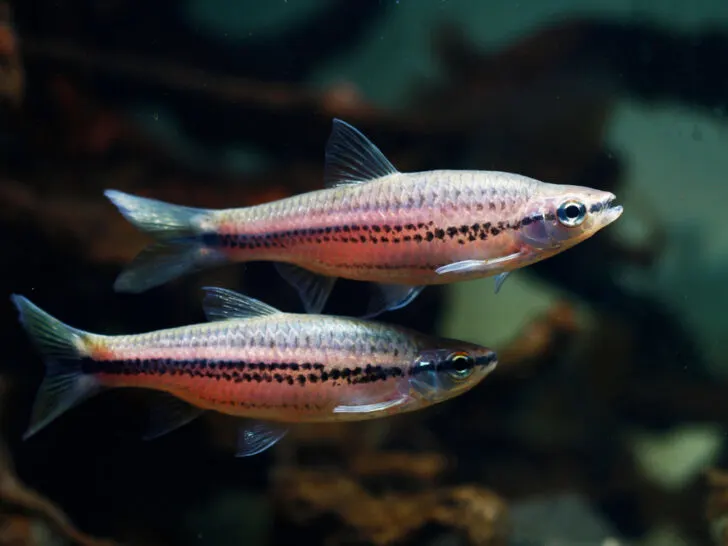
The Porthole Rasbora (Rasbora cephalotaenia) is a freshwater fish native to Southeast Asia, specifically the Malay Peninsula, Sumatra, and Borneo. This rasbora is very popular with fishkeepers due to its attractive silver-gray coloration, which exhibits a metallic shine.
The black bands that run horizontally on its body, contrasted against its white spots, give it an eye-catching look. They are one of the larger rasbora species, as they can grow up to around 5 inches (13 cm) in length when fully grown.
This species prefers a pH level of 3.0 and temperatures between 72-80°F (22-27 degrees Celsius). They are schooling fish and can be housed in groups of six or more. Their aquarium should be lit dimly and have plenty of hiding places.
Also, as they are used to peat, adding brown leaf litter and driftwood to the tank could bring out their natural behavior. These fish can be fed live, frozen, or freeze-dried food.
12. Scissortail Rasbora’ Rasbora trilineata’
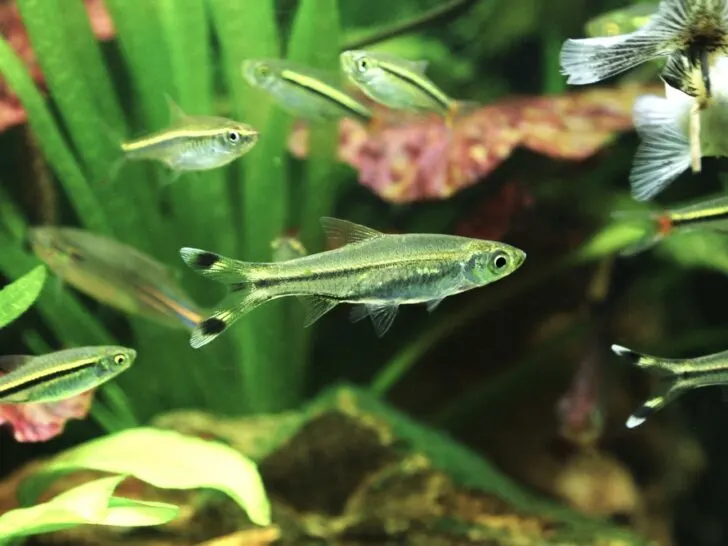
The Scissortail Rasbora (Rasbora trilineata) is an elegant fish species that can add vibrancy to any tank. This species is characterized by its long, pointed tail fin, which resembles a pair of scissors.
It has an attractive silvery-brown body with a slender frame and black stripes running along its sides. These fish prefer to school in medium to large tanks, so it’s best to keep them in groups of six or more.
The Scissortail Rasbora is carnivorous. They require plenty of swimming space, so a tank with plenty of open water is ideal for about twenty gallons.
The Scissortail Rasbora can reach up to 3.5 inches (9 cm) in length. This species is quite easy to care for. They are not finicky about the tank’s decor, but you can add driftwood, plants, and rocks to their tank.
13. Sidestripe Rasbora’ Rasbora paviana’
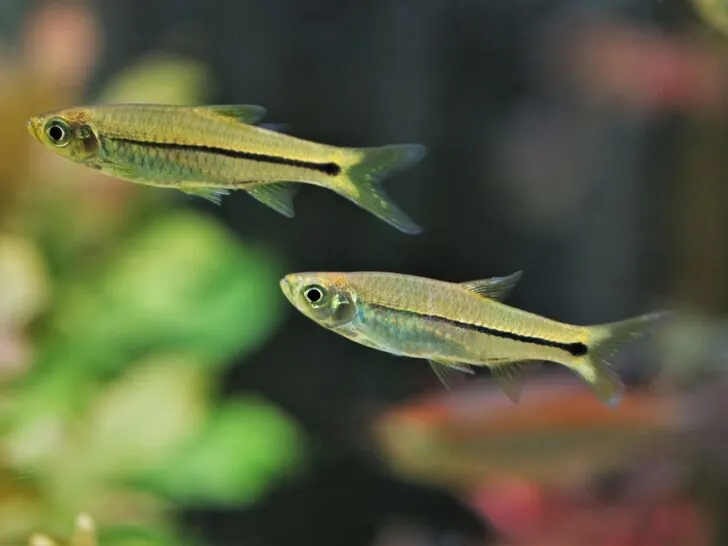
Originating from Thailand and parts of Southeast Asia, the Sidestripe Rasbora (Rasbora paviana) is a beautiful fish with a unique striped pattern running along its side. It is a peaceful fish that pairs well with other non-aggressive species.
The male is slightly more colorful than the female, and its body is a bit slimmer. Their growth rate is slow, and they can reach up to 3.5 inches (9 cm) in length. It prefers a neutral pH value, an optimum temperature of 73-77°F (23-25°C), and soft to medium hard water.
Your tank should have a lid, as these fish can jump out of an open tank. The water should always be clean with no accumulation of organic waste.
Its diet primarily consists of invertebrates like crustaceans, algae, and other small creatures. The Sidestripe Rasbora will do best in heavily planted tanks to provide hiding places and enough oxygenated water.
14. Strawberry Rasbora ‘Boraras naevus’
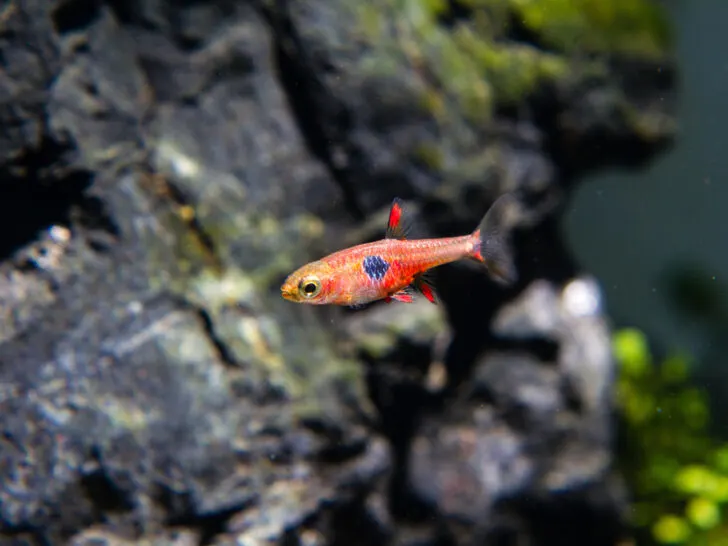
Strawberry rasboras are commonly confused with chili rasboras. But the unique difference between these two is that Strawberry Rasbora has a black dot on the side of its body which is absent in Chili Rasboras.
These tiny fish can grow up to 0.7 inches (1.8 cm) and have shimmering red color bodies along with a black spot on their side just above the pectoral fin, which is very attractive. They usually live in slow-moving waters with plenty of vegetation and leaf litter.
Acidic water with a pH between 6.0 and 7.2 is preferred for these fishes, but they can also survive in soft to moderate water hardness. They do well in nano tanks and can also be kept in groups of twelve.
15. Yellowtail Rasbora ‘Rasbora tornieri’

With sleek silver bodies, two yellow horizontal strips running over the length of their bodies, and bright yellow tails, these fish are stunners. The Yellowtail Rasbora is native to Southeast Asia and spends most of its time swimming around the middle levels of your tank.
They prefer to be kept in groups of six and thrive in tanks with plenty of plants and bogwood for shelter. With a growth of up to six inches (15 cm), you may need a lid to keep them from jumping out of your tank.
They can be fed a variety of food options such as flakes, pellets, and frozen foods. They are not great for a beginner’s aquarium, as they are a bit more finicky when it comes to water parameters and tank size.
Final Thoughts
Rasboras come in all shapes and sizes, each with unique beauty. If you want to add color and vibrancy to your tank, these fish are sure to do the trick. They can also be peaceful with other tankmates and make wonderful additions to your community tank.

